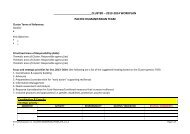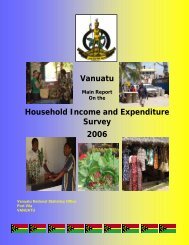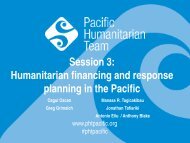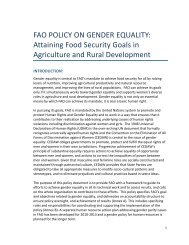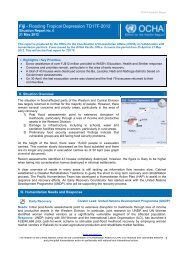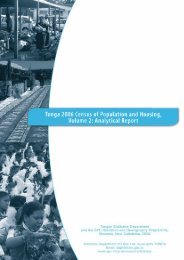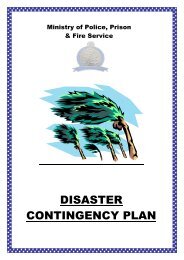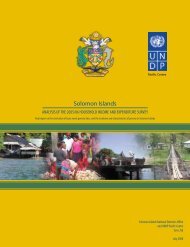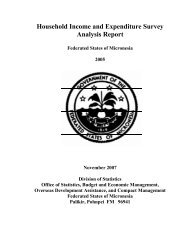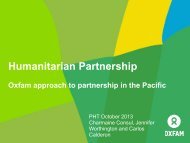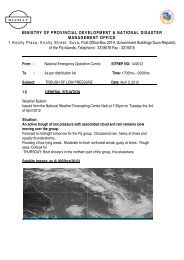SAMOA FLOOD MANAGEMENT ACTION PLAN 2007-2012 - Pacific ...
SAMOA FLOOD MANAGEMENT ACTION PLAN 2007-2012 - Pacific ...
SAMOA FLOOD MANAGEMENT ACTION PLAN 2007-2012 - Pacific ...
You also want an ePaper? Increase the reach of your titles
YUMPU automatically turns print PDFs into web optimized ePapers that Google loves.
Recommended actions:If increasing the channel conveyance of the lower Vaisigano River was to beconsidered in more detail then the following actions would be required:o Improve the accuracy of the topographic and hydrological data available for thelower Vaisigano River and its floodplain in order to reduce the uncertainty in thedesign flood levels.o Establish the quantity of cut that would need to removed to widen and deepen theLower Vaisigano to prevent flooding for a number of design return periods.o Make a preliminary assessment of the costs of increasing the conveyance of thelower Vaisigano.o Quantify the economic benefits that are derived by increasing the conveyance ofthe lower Vaisigano for a number of return periods.o Assess land ownership issues in the Lower Vaisigano and establish the cost ofrelocation of communities adjacent to the river.o Assess the sediment load in the river and quantify the amount of material thatwould have to be dredged from the river in order to maintain the new channelprofile and cross-section.o Make a preliminary assessment of the environmental impacts including the visualimpacts of constructing this option3.2.5. PumpingPumping is an effective flood mitigation measure for relatively small catchments (e.g.in Samoa this probably means less than 1 km 2 ) where the flood volumes are not toogreat. However, in the case of the Lower Vaisigano where the flows are high (e.g.the 1 in 2 year flow is 174 m 3 /s), pumping is not a practical option owing to the size ofpumps required to lift such large volumes of water. The capital, and operation andmaintenance costs of pumps would be prohibitively high.3.2.6. River maintenanceRiver maintenance is used to reduce flood risk by a number of measures including:o Dredging.o Vegetation cutting.o Bank clearance.o Removal of obstructions and rubbish that may block structures such as bridges.The HEC-RAS hydraulic model of the Vaisigano River has shown that dredging thelower reaches of the river downstream of Leone Bridge by up to 2 m would only havea minimal effect on the depth of water in the floodplain. The same is true of cuttingvegetation and bank clearance. The Manning’s n roughness coefficient is currentlyset at 0.035 in the hydraulic model. Assuming that the weed cutting and bankclearance reduces this roughness coefficient to 0.025 then the 1 in 100 year floodwater level in the lower Vaisigano will only drop by some 0.22 m. This will provide aminimal amount of benefit to the elements at risk from flooding. In practice it isunlikely that the cutting vegetation and clearing the banks will reduce the roughnesscoefficient to 0.025. The removal of obstacles and rubbish that may block bridgeswould be a useful exercise but again is unlikely to have a significant effect on peakflood water levels.Flood management Action Plan <strong>2007</strong> 28



